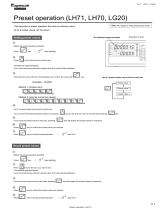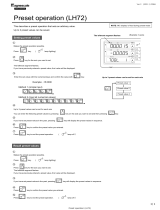
Contents
Read this first! (For AW‑UE150WP, AW‑UE150KP) ............................ 2
Read this first! (For AW‑UE150WE, AW‑UE150KE) ............................ 3
Read this first! ...................................................................................... 6
Note on grounding ............................................................................... 6
Before use .............................................................................................. 8
Overview .............................................................................................. 8
Computer requirements ....................................................................... 8
Disclaimer of warranty ......................................................................... 9
Network security .................................................................................. 9
Features................................................................................................ 10
Accessories ......................................................................................... 11
Optional accessories .......................................................................... 11
Operating precautions ........................................................................ 12
Wireless remote control (optional accessory).................................. 14
Parts and their functions .................................................................... 15
Camera unit ....................................................................................... 15
Wireless remote control: AW-RM50G (optional accessory)............... 22
Setting the remote control IDs ........................................................... 24
Network settings.................................................................................. 25
Use the Easy IP Setup Software to establish the unit’s settings........ 25
Setting the initial account ................................................................... 26
Installing the plug-in viewer software ................................................. 26
Basic shooting operations ................................................................. 27
How to turn the power on and off ...................................................... 28
Turning the power on ......................................................................... 28
Turning the power off ......................................................................... 28
Selecting the units ...............................................................................29
Selecting the shooting modes (scene files)...................................... 30
Types of shooting modes ................................................................... 30
How to select the shooting mode ....................................................... 30
Shooting ............................................................................................... 31
What to do when encountering problems in the basic shooting
operations ........................................................................................ 32
More advanced operations ................................................................. 33
Manual shooting .................................................................................. 34
Manually adjusting the focus.............................................................. 34
Manually adjusting the iris.................................................................. 34
Manually adjusting the shutter speed ................................................ 34
Manually adjusting the gain ............................................................... 34
Preset memories.................................................................................. 35
White balance adjustment .................................................................. 36
Automatic adjustment (AWB: AWB A or AWB B) .............................. 36
Auto tracking white adjustment (ATW)............................................... 37
3200K and 5600K presets ................................................................. 37
VAR.................................................................................................... 37
Black balance adjustment .................................................................. 38
Automatic adjustment ........................................................................ 38
Black level (master pedestal) adjustment ......................................... 39
Genlock adjustment ............................................................................ 40
Horizontal phase adjustment ............................................................. 40
Basic setup operations ....................................................................... 41
When performing the operations using the wireless remote control
... 41
Camera menu items ............................................................................ 42
Setting the camera menu items ......................................................... 42
Top Menu screen ............................................................................... 42
Camera screen .................................................................................. 43
Brightness 1/2 screen ........................................................................ 43
Brightness 2/2 screen ........................................................................ 44
Picture 1/8 screen .............................................................................. 45
Color TEMP. Setting screen .............................................................. 46
Picture 2/8 screen .............................................................................. 47
Picture 3/8 screen .............................................................................. 47
Picture 4/8 screen .............................................................................. 48
Picture 5/8 screen .............................................................................. 48
Picture 6/8 screen .............................................................................. 49
Picture 7/8 screen .............................................................................. 50
Picture 8/8 screen .............................................................................. 51
Matrix 1/5 screen ............................................................................... 51
Matrix 2/5 screen ............................................................................... 52
Matrix 3/5 screen ............................................................................... 52
Matrix 4/5 screen ............................................................................... 53
Matrix 5/5 screen ............................................................................... 53
Lens screen ....................................................................................... 54
System screen ................................................................................... 54
Output 1/6 screen .............................................................................. 56
Output 2/6 screen .............................................................................. 58
Output 3/6 screen .............................................................................. 59
Output 4/6 screen .............................................................................. 59
Output 5/6 screen .............................................................................. 60
Output 6/6 screen .............................................................................. 60
Pan/Tilt screen ................................................................................... 62
Preset 1/2 screen ............................................................................... 63
Preset 2/2 screen ............................................................................... 64
Maintenance screen........................................................................... 64
Firmware Version 1/2 screen ............................................................. 65
Firmware Version 2/2 screen ............................................................. 65
IP Network screen.............................................................................. 66
Hour Meter screen ............................................................................. 67
Error Status screen ............................................................................ 67
Camera menu item table ..................................................................... 68
Displaying the web screen ................................................................. 75
Displaying the web screen using a personal computer...................... 75
Switching between the Live screen [Live] and Web setup screen
[Setup] ........................................................................................... 77
Logging into the Web screen ............................................................. 77
Web screen operations ....................................................................... 78
Live screen [Live] ............................................................................... 78
Web screen configurations ................................................................ 83
Web setup screen [Setup].................................................................. 83
Setting status screen [Setting status]................................................. 84
Basic screen [Basic]........................................................................... 85
Image screen [Image/Audio] .............................................................. 92
User management screen [User mng.] ............................................ 113
Network setup screen [Network] ...................................................... 115
Maintenance screen [Maintenance] ................................................. 128
Displaying the web screen using a personal computer equipped
with a touch panel ......................................................................... 132
Displaying the web screen using a mobile terminal ...................... 134
Camera control screen [Camera Control] ........................................ 134
Limiters............................................................................................... 136
Setting/releasing the limiters ........................................................... 137
Basic limiter operations .................................................................... 137
Setting the limiters ........................................................................... 137
Releasing the limiters....................................................................... 137
Resetting the limiters ....................................................................... 137
Safe mode .......................................................................................... 138
Concerning the safe mode ............................................................... 138
Detection of equipment trouble ........................................................ 138
Troubleshooting ................................................................................ 139
Specifications .................................................................................... 148
Index ...................................................................................................150
6 7





















